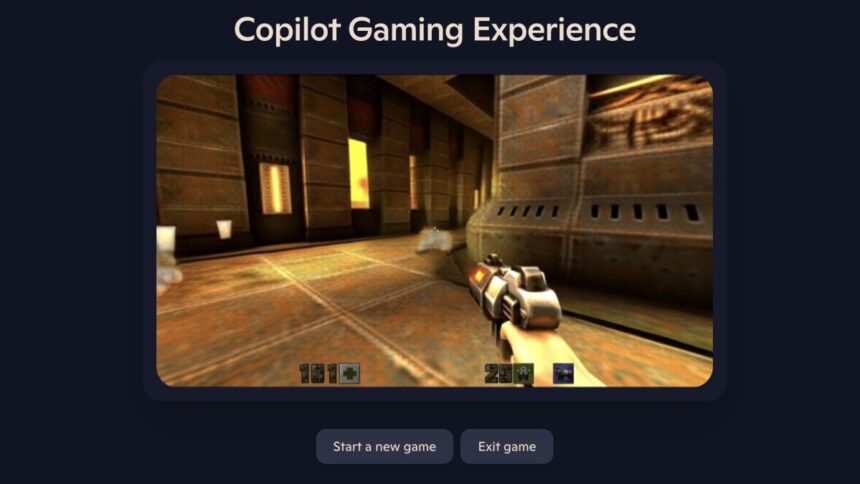The Rise of AI in Interactive Gaming: A Look at a Unique Experience
Artificial Intelligence (AI) has rapidly become a ubiquitous presence in various domains. Many have experimented with AI tools to create text, images, audio, or even videos. However, the influence of AI extends beyond passive media consumption, as companies delve into interactive entertainment, including video games.
In recent months, various innovations have emerged. Google has introduced its Genie model, designed to craft playable gaming landscapes from user input. Meanwhile, Microsoft has unveiled a comparable model named Muse, offering a fresh take on gaming found in its experimental AI-driven version of Quake II, initially released in 1997.
The experience of playing the AI-enhanced Quake is undeniably peculiar. Engaging with this version feels akin to navigating a surreal dream state—not necessarily due to quality, but rather the distinctive, unstable nature of the gameplay. Beyond initial novelty, one might question the purpose of such a creation.
Experiencing AI Quake
Upon launching the “Copilot Gaming Experience,” players are greeted by a message confirming they are over 18, despite the game being rated for those 17 and older. This serves as an early sign that something is amiss.
The game appears in a confined window at the center of the screen, and it’s immediately apparent that something feels off. It retains traits of a conventional video game, featuring a first-person perspective with an animated arm brandishing a pistol, complemented by a health meter, ammo count, and weapon display. However, an unsettling quality permeates the experience, exacerbated upon pressing any button.

A noticeable lag of approximately one second exists between keyboard input and on-screen action. This delay is only one aspect of the experience; as movement occurs, the surroundings appear to shift subtly, suggesting an unstable environment. Initially devoid of enemies, adversaries materialize unpredictably as the player navigates, emerging without any animation or logical spawn behavior—just one moment they’re simply there.
Gameplay mechanics resemble SuperHot, where time halts during moments of inactivity. Enemies become immobile, and any action taken triggers chaotic scene transformations—monsters may move unnaturally, shift shapes due to AI algorithms, or entire rooms could alter in real-time.
Some semblance of consistency does exist, as players start in the same room. However, maintaining map integrity while navigating can prove difficult, especially with the threat of newly spawned enemies that lack clarity. This aspect contributes to the dreamlike quality, creating an unsettling atmosphere where the environment feels prone to sudden shifts.
Instability in Gameplay
Entering rooms presents unique challenges. Often, confrontations with enemies dissolve into ephemeral encounters where turning around causes them to vanish, as if the shifting ground itself erased them. Dodging attacks via lateral movement also contributes to this bizarre phenomenon.
Interestingly, the player character cannot perish. Though it may seem like health is declining, the numeric display bounces erratically, and even upon reaching zero, the character remains intact. The count fluctuates endlessly until the player disposes of the enemy or the AI chooses to remove it entirely from the scene.
What do you think so far?
When Gameplay Fails
The game often encounters abrupt glitches. During one playthrough, while scanning the room, a hallway transformed into an elevator, leading to a perpetually loading screen upon pressing the button. Another time, a simple rotation brought the player to an entirely different room, with inexplicable health loss occurring without any visible enemies. As tension built, the game froze, akin to earlier experiences, compelling the player to restart.

The Essence of Gaming: Should It Be Fun?
This version of Quake runs on Microsoft’s WHAM model, developed with human gameplay data to predict on-screen elements and potential player actions. Microsoft’s research publication touts the advantages of an AI capable of producing gaming worlds.
However, the premise falls short of traditional fun. The primary engagement seems to be enduring the experience without it collapsing. While players can eliminate foes, they present no real threat. The AI may even intervene, negating any chance of being defeated if movement is miscalculated.
It’s likely that further refinements will come from Microsoft, resulting in a more cohesive gaming experience with grounded enemies and achievable objectives. Yet, the question remains: why would anyone want to engage with a game crafted from random assemblages of existing titles?
There exists potential for AI to augment gaming development, yet it should function as an enhancement to a developer’s toolkit rather than rendering them obsolete. In its current state, AI-generated gaming still has a long way to go, ensuring that traditional game developers maintain an essential role in the industry.












